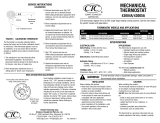
Crestron CHV-TSTAT and CHV-THSTAT Thermostats
Operations and Installation Guide – DOC. 8163E Contents
i
Contents
Quick Installation Reference .................................................................................................... iii
Thermostats: CHV-TSTAT and CHV-THSTAT 1
Introduction ............................................................................................................................... 1
Features and Functions ................................................................................................ 1
Specifications .............................................................................................................. 4
Physical Description .................................................................................................... 5
Setup .......................................................................................................................................... 9
Network Wiring ........................................................................................................... 9
Identity Code ............................................................................................................... 9
System Connections .................................................................................................. 10
Wiring Diagrams ..................................................................................................................... 11
Separately Powered Two Wire Heat Systems (Powered by an Independent
Transformer) .............................................................................................................. 12
1-Stage Heat Only Systems ....................................................................................... 12
1-Stage Heat with Fan Control Systems .................................................................... 13
1-Stage Cool Only Systems ....................................................................................... 13
1-Stage Heat/Cool with Integrated Control Unit Systems ......................................... 14
1-Stage Heat/Cool with Separate Systems ................................................................ 15
1-Stage Heat Pump Systems ...................................................................................... 16
2-Stage Heat Pump Systems ...................................................................................... 17
Slab 1, Slab 2, and Slab 3 (Floor Warming and/or Space Heating) Systems ............ 18
Slab 4A 2-Stage Heat/1-Stage Cool Systems and Slab 5A Floor Warming with
1-Stage Space Heat/Cool Systems ............................................................................. 19
Slab 4B 2-Stage Heat/1-Stage Cool System and Slab 5B 1-Stage Heat/Cool with
Floor Warming Systems ............................................................................................ 20
General Humidifier Connections ............................................................................... 21
Installation ............................................................................................................................... 22
Thermostat Setup ..................................................................................................................... 24
Setup Procedure ......................................................................................................... 24
Setup Notes................................................................................................................ 24
System Types and Definitions ................................................................................... 25
Heat/Cool, 1 or 2-Stages, Forced Air or Radiant ....................................................... 27
Heat Pump, 1 or 2-Stages, Aux Heat or Dual Fuel .................................................... 31
Slab 1 – Floor Warming Only ................................................................................... 35
Slab 2 – 1-Stage Space Heat with Slab Maximum .................................................... 39
Slab 3 – 1-Stage Heat with Slab Minimum/Maximum .............................................. 43
Slab 4A – 2-Stage Heat/One Stage Cool with Slab Maximum ................................. 47
Slab 4B – 2-Stage Heat/1-Stage Cool with Slab Maximum (Heat Pump) ................. 51
Slab 5A – 1-Stage Heat/Cool with Floor Warming ................................................... 55
Slab 5B – 1-Stage Heat/Cool with Floor Warming (Heat Pump) .............................. 59
Thermostat Operation .............................................................................................................. 63
View Button Menus ................................................................................................... 64
Mode Button Menus .................................................................................................. 65
Uploading and Upgrading ........................................................................................................ 72
Establishing Communication ..................................................................................... 72





















